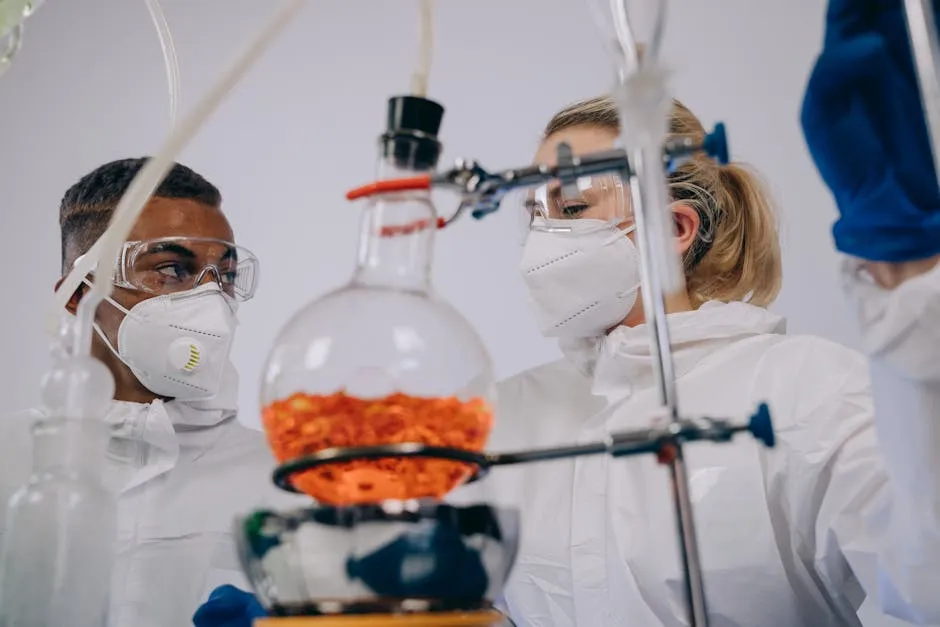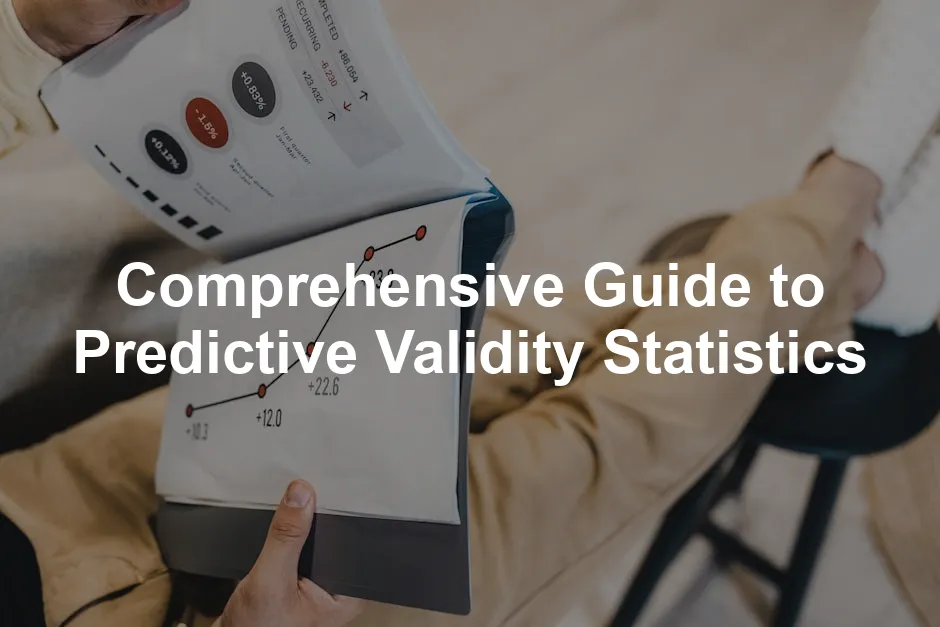Introduction
Predictive validity is a critical concept in statistics and research. Simply put, it measures how well a test or assessment can forecast future outcomes. Imagine using last week’s weather to predict today’s sunshine; predictive validity works in much the same way. It’s essential for researchers and practitioners to know whether their tools genuinely predict what they intend to measure.
This concept is especially relevant in fields like psychology, education, and employment. For instance, in psychology, assessments aim to predict behaviors or mental health outcomes. In education, standardized tests like the SAT aim to forecast a student’s future academic performance. Even in hiring processes, pre-employment tests help predict how well candidates will perform on the job.
In this article, we will cover key concepts of predictive validity, methods of measurement, and real-world examples. We’ll also answer frequently asked questions to provide a comprehensive understanding of this essential topic. Whether you’re a researcher, educator, or hiring manager, grasping predictive validity can enhance your decision-making and improve outcomes.

Understanding Predictive Validity
What is Predictive Validity?
Predictive validity refers to how well a specific measure predicts future performance or behavior. It’s a subtype of criterion validity, which assesses how effectively a test predicts an outcome based on a criterion measure. Think of it as a crystal ball—when you look into it, you want to see a clear image of future results based on current data.
The primary goal of predictive validity is to ensure that a test can forecast an outcome accurately. For example, if a test is designed to predict job performance, it must demonstrate that high scores correlate with better performance ratings from supervisors. This correlation provides evidence of the test’s predictive validity.
It’s essential to distinguish predictive validity from concurrent validity. While both measures assess the relationship between a test and an outcome, predictive validity looks ahead. Concurrent validity, on the other hand, compares test scores and outcomes gathered simultaneously. Understanding this difference is crucial for researchers and practitioners aiming to choose the right measurement tools for their needs.
If you’re preparing for college entrance exams, you might want to check out some top-rated SAT Prep Books. These books can guide you through the study process, ensuring you’re well-prepared for the big day!

Importance of Predictive Validity
Predictive validity plays a vital role in various domains, especially when making critical decisions. In hiring, for instance, employers rely on tests to predict which candidates will excel in their roles. A hiring manager wouldn’t want to gamble on a candidate who might not perform well, right? That’s where predictive validity comes into play. By ensuring that assessment tools have strong predictive validity, organizations can make informed hiring decisions.
In educational settings, predictive validity helps determine which students are likely to succeed in higher education. Standardized tests are often used to forecast future GPA based on past performance. If these tests demonstrate strong predictive validity, educators can identify students who may need additional support before they even step into the classroom.
Moreover, predictive validity can be a game-changer in health screenings. For example, a test designed to predict the likelihood of developing a certain disease can guide interventions and preventive measures. By ensuring that such assessments have strong predictive validity, healthcare providers can improve patient outcomes.
Speaking of health, if you’re looking to keep track of your wellness, consider a Health Screening Kit. These kits often include cholesterol tests and can provide valuable insights into your health!
In summary, predictive validity is not just a statistical concept; it’s a critical factor that influences decision-making across various fields. Whether you’re hiring a new employee, selecting students for a program, or assessing health risks, understanding predictive validity ensures that you’re using the right tools to make informed decisions.

Measuring Predictive Validity
Methods of Measurement
Measuring predictive validity is like testing a crystal ball. You want to know how well it predicts future events based on current data. Typical methodologies include correlation analysis, which assesses the relationship between two variables. When we talk about predictive validity, we often refer to statistical techniques like Pearson’s r, regression analysis, and odds ratios.
Pearson’s r measures the strength and direction of a linear relationship between two variables. The value ranges from -1 (perfect negative correlation) to +1 (perfect positive correlation). A high positive value suggests that as one variable increases, the other does too. Conversely, a high negative value indicates that as one variable increases, the other decreases. This tool is essential for validating predictive models.
Regression analysis goes a step further. It helps us predict the value of one variable based on the value of another. For instance, a company might use regression to forecast employee performance based on test scores. This technique shows not just correlation, but also how changes in predictor variables impact the criterion variable.
If you’re interested in diving deeper into statistical methods, consider picking up a solid Statistical Methodology Book. These resources can provide you with the tools needed for accurate analysis.

Odds ratios are particularly useful in binary outcomes, like predicting job success (yes or no). They provide insight into the likelihood of an event occurring, making them invaluable for understanding how various factors contribute to outcomes.
Steps to Measure Predictive Validity
Conducting a predictive validity study is a systematic process. Here’s a step-by-step guide to get you started:
- Collect Scores on the Predictor Variable: Begin by administering the test or assessment you want to validate. This could be a pre-employment test, for example. Record the scores of all participants.
- Wait for a Predetermined Period: After collecting the predictor scores, allow time to pass. This could be weeks, months, or even years, depending on the context. The goal is to gather data on the criterion variable after some time has elapsed.
- Collect Data on the Criterion Variable: After the waiting period, collect data on the outcome you’re interested in predicting. For example, if you’re measuring job performance, gather performance ratings from supervisors.
- Calculate Correlation Coefficients: Now, it’s time for some math! Use statistical software to calculate correlation coefficients between the predictor scores and the criterion outcomes. This will give you a numerical representation of predictive validity. A strong positive correlation (close to 1) indicates that the predictor effectively forecasts the outcome.
- Analyze the Results: Interpret the results. High correlations suggest strong predictive validity, while low correlations may indicate the need for adjustments to your predictor variable or measurement method.
Understanding how to measure predictive validity can greatly enhance your research. statistical methods for finance professionals 2024

Evaluating Predictive Validity
Interpreting the results of predictive validity studies is crucial. A strong correlation (e.g., r > 0.5) suggests that the predictor variable reliably forecasts the outcome. However, it’s essential to consider the context. For instance, in social sciences, correlations are often lower, and even a modest r of 0.3 can still provide valuable insights.
Several factors can influence predictive validity. Sample size is one. Smaller samples may yield less reliable results, while larger samples often provide more stable estimates. Additionally, range restriction can skew correlations. If you only test high-performing individuals, the correlation may appear artificially inflated.
In conclusion, measuring predictive validity involves a thoughtful approach, combining statistical rigor with practical considerations. By following these steps and understanding the context, researchers can ensure their assessments are genuinely predictive, ultimately leading to better decision-making in various fields.

Examples of Predictive Validity
Real-World Examples
Predictive validity shines a light on how well a measure predicts future outcomes. To better understand its real-world implications, let’s look at some practical examples and case studies.
- Example 1: College Admissions Tests College admissions tests like the SAT and ACT are designed to forecast a student’s potential academic performance. Research shows a strong correlation between SAT scores and first-year college GPA. In fact, studies reveal an average correlation of around 0.50. This means that students who score higher on these tests are likely to achieve better grades in their first year of college. This relationship is so compelling that many universities rely on these scores during their selection process, believing they can effectively predict student success. So, if your SAT scores are soaring, gear up for a GPA that matches!
- Example 2: Employee Selection Pre-employment tests serve as a crystal ball for job performance. Organizations often use assessments to predict how well candidates will perform in their roles. A significant body of research indicates that cognitive ability tests can correlate with job performance at an average of 0.35. This means that higher test scores generally lead to better performance ratings from supervisors. For employers, this predictive validity helps streamline hiring processes, ensuring they select candidates who are likely to excel. So, those tricky personality quizzes and skill tests? They’re not just for fun—they’re a window into your potential job performance!
- Example 3: Health Screening Predictive validity also plays a significant role in health assessments. Certain screenings can predict future health outcomes, such as the likelihood of developing chronic diseases. For instance, body mass index (BMI) and cholesterol levels are often used to forecast the risk of heart disease. Studies show that a high BMI correlates with increased heart disease risk, with a correlation coefficient of around 0.40. This relationship can guide lifestyle interventions and preventive measures before serious health issues arise. So, those routine check-ups? They’re not just about today—they’re about shaping your health tomorrow!

Speaking of keeping track of your health, a BMI Measuring Scale can help you monitor your weight and adjust your health plans accordingly!

Case Studies
- College Admissions: A comprehensive study at a major university evaluated the predictive validity of their admissions criteria, including standardized test scores and high school GPAs. Researchers discovered a correlation of 0.55 between SAT scores and first-year GPA, reinforcing the test’s role in predicting academic success. This finding led the university to emphasize standardized testing in their admissions process, aiming to enhance student retention and graduation rates.
- Employee Performance: A multinational corporation implemented a new cognitive assessment for potential hires. After one year, they analyzed the performance ratings of these employees in comparison to their test scores. The results were impressive, with a correlation of 0.45 found between test performance and job success. This prompted the company to refine their recruitment strategy, relying more heavily on this predictive measure to identify top talent.
- Health Interventions: A public health study examined the predictive validity of a new screening tool for diabetes. Researchers tracked participants over five years, correlating initial screening results with actual diabetes diagnoses. The findings revealed a correlation coefficient of 0.65, indicating strong predictive validity. As a result, public health officials adopted the screening tool widely, using it to identify at-risk individuals and implement early intervention programs.
These examples and case studies illustrate the power of predictive validity across various sectors. From education to employment and health, understanding and utilizing predictive validity can lead to informed decisions that improve outcomes and enhance overall effectiveness. So, the next time you encounter a test or assessment, remember—it’s not just a number; it’s a glimpse into the future!

Challenges and Limitations of Predictive Validity
Common Issues
When it comes to predictive validity, challenges lurk around every corner. One major hurdle is bias. Selection bias occurs when the sample used for testing isn’t representative of the broader population. For instance, if a college admissions test only evaluates high-achieving students, it may not accurately predict the success of a diverse student body. This oversight can lead to misguided conclusions about the test’s effectiveness.
Response bias also complicates matters. Imagine participants answering questions based on what they think the researchers want to hear. This tendency can skew results, making it difficult to ascertain true predictive validity. Accurate self-reporting is crucial, yet it often falls victim to social desirability effects, where individuals present themselves in a more favorable light than reality.
Moreover, relying solely on predictive validity for decision-making is risky. It’s like using a single compass direction to navigate a complex maze. While predictive validity offers valuable insights, it doesn’t account for all variables influencing outcomes. For example, in employment settings, a pre-employment test might forecast job performance, but it can’t predict cultural fit or adaptability—elements equally crucial for success.
Lastly, consider the time factor. Predictive validity assessments often require long-term follow-ups to gather meaningful data. This delay can hinder timely decision-making, especially in fast-paced environments.

Addressing the Challenges
So, how can researchers and practitioners tackle these challenges? First off, it’s vital to ensure representative sampling. By including a diverse range of participants, the findings become more generalizable. This approach mitigates selection bias and enhances the test’s predictive power across different demographics.
Next, employing multiple assessment methods can provide a more holistic view. For instance, combining tests with interviews and reference checks can lead to a more rounded evaluation of a candidate’s potential. This strategy reduces reliance on any single measure, thereby minimizing the impact of response bias.
To further combat biases, transparency is key. Researchers should be upfront about their methodologies and potential limitations. Sharing findings and methodologies not only fosters trust but also invites scrutiny that can lead to improvements in study design.
Lastly, consider incorporating shorter-term assessments alongside long-term follow-ups. This tactic helps in making more immediate decisions while still gathering valuable data for future predictions. By blending different timeframes, organizations can maintain agility without sacrificing accuracy.
In short, while predictive validity presents challenges, addressing them head-on ensures that assessments remain robust and reliable. Balancing predictive power with practical considerations is the sweet spot for effective decision-making.

Best Practices for Utilizing Predictive Validity
Harnessing Predictive Validity Effectively
Harnessing predictive validity effectively requires a strategic approach. Start by designing studies that are clear and focused. Define your objectives upfront, ensuring that your assessment tools align with these goals. A well-defined purpose sets the stage for meaningful results.
Next, embrace a multi-method approach. Relying on various assessment techniques—like tests, interviews, and observations—can provide a comprehensive view of an individual’s potential. This variety enriches the data pool, allowing for more nuanced conclusions. Each method captures different dimensions of a candidate’s abilities, ultimately enhancing predictive validity.
Objectivity is crucial too. Maintain neutrality in study design by avoiding leading questions or biased scenarios. Objective measures increase the validity of findings, helping to ensure that results reflect reality rather than researcher expectations.
Another best practice is to continually validate your assessments. Periodically review and update your tools to reflect current trends and findings. As industries evolve, so too should the measures used to assess potential. This ongoing refinement keeps your predictive validity relevant and reliable.
Finally, don’t overlook the importance of training evaluators. Ensure that those administering assessments understand the tools and their intended outcomes. Well-trained evaluators can better interpret results, reducing misapplications of predictive data.
Incorporating these best practices can lead to a more effective use of predictive validity, ultimately enhancing decision-making processes across various fields.

Conclusion
Predictive validity statistics are crucial in research and practical applications. They provide a framework for evaluating how well a test or assessment can forecast future outcomes. This is especially important in fields like psychology, education, and employment, where making informed decisions can significantly impact individuals and organizations.
In educational settings, for example, predictive validity helps teachers and administrators gauge which students are likely to succeed academically. Standardized tests, such as the SAT and ACT, are designed to predict future college performance based on students’ current abilities. When these assessments demonstrate high predictive validity, educators can better identify students who may need additional support or resources, ultimately leading to improved academic outcomes.
In the world of employment, predictive validity plays a vital role in the hiring process. Employers use various assessment tools to determine which candidates are likely to excel in their roles. A pre-employment test with strong predictive validity can streamline hiring, ensuring that organizations select individuals who are more likely to thrive in their positions. This not only benefits the company but also enhances employee satisfaction and retention.
Moreover, predictive validity isn’t just a theoretical concept; it’s a practical tool. It helps researchers, educators, and employers make data-driven decisions that can lead to better outcomes. By understanding the predictive capabilities of their assessments, these professionals can refine their approaches, adapt interventions, and ultimately enhance overall effectiveness.
Therefore, it’s essential to consider predictive validity when designing assessments or making decisions based on test scores. Whether you’re developing a new psychological test, crafting educational assessments, or refining hiring processes, embracing predictive validity will lead to more accurate and effective outcomes. In a world that often relies on data, leveraging the power of predictive validity statistics can empower you to make decisions that truly matter.

FAQs
What is the difference between predictive validity and concurrent validity?
Predictive validity and concurrent validity are both subtypes of criterion validity, but they measure different aspects of this relationship. Predictive validity refers to how well a test score can forecast a future outcome, measured at a later time. For instance, if a pre-employment test predicts job performance one year later, it demonstrates predictive validity. On the other hand, concurrent validity assesses the correlation between test scores and criterion outcomes obtained simultaneously. For example, if a cognitive ability test is administered alongside job performance ratings, the correlation between the two indicates concurrent validity. Essentially, predictive validity looks ahead, while concurrent validity evaluates the present.
How can predictive validity be applied in educational settings?
In educational settings, predictive validity is vital for assessing student performance and readiness. For instance, standardized tests like the SAT and ACT are used to predict future college success based on high school performance. These assessments help educators identify students who may need additional support or advanced coursework. By ensuring that these tests have strong predictive validity, schools can make informed decisions about curriculum design, resource allocation, and student placement, leading to better educational outcomes.
What are some common statistical methods used to determine predictive validity?
Several statistical methods are used to assess predictive validity. Common techniques include correlation analysis, where researchers calculate correlation coefficients, such as Pearson’s r, to evaluate the strength and direction of the relationship between test scores and outcomes. Regression analysis is another method, enabling researchers to predict the value of one variable based on another. Additionally, odds ratios and logistic regression are frequently applied in predictive validity studies, especially in the context of binary outcomes, like pass/fail scenarios.
How does sample size affect predictive validity?
Sample size plays a significant role in determining the reliability of predictive validity findings. Generally, larger samples yield more stable and generalizable results. Small samples may lead to inflated or deflated correlation coefficients, making it difficult to draw accurate conclusions about predictive validity. Inadequate sample sizes can also increase the risk of Type I or Type II errors, where researchers mistakenly identify a relationship that doesn’t exist or fail to detect a true relationship. Therefore, ensuring an appropriate sample size is essential for robust predictive validity assessments.
Can predictive validity be influenced by external factors?
Yes, predictive validity can be influenced by external factors. Variables such as socio-economic status, cultural background, and environmental conditions can impact the relationship between test scores and outcomes. For instance, if a standardized test is biased toward a specific demographic, its predictive validity may not hold true across diverse populations. Additionally, changes in the job market or educational landscape can alter the predictive capacity of assessments over time. Researchers must account for these external influences to ensure that their predictive validity studies yield accurate and meaningful results.
Please let us know what you think about our content by leaving a comment down below!
Thank you for reading till here 🙂
And if you’re looking to organize your study schedule, an Academic Planner could be a game changer! Stay on top of your deadlines and appointments like a pro!
All images from Pexels




